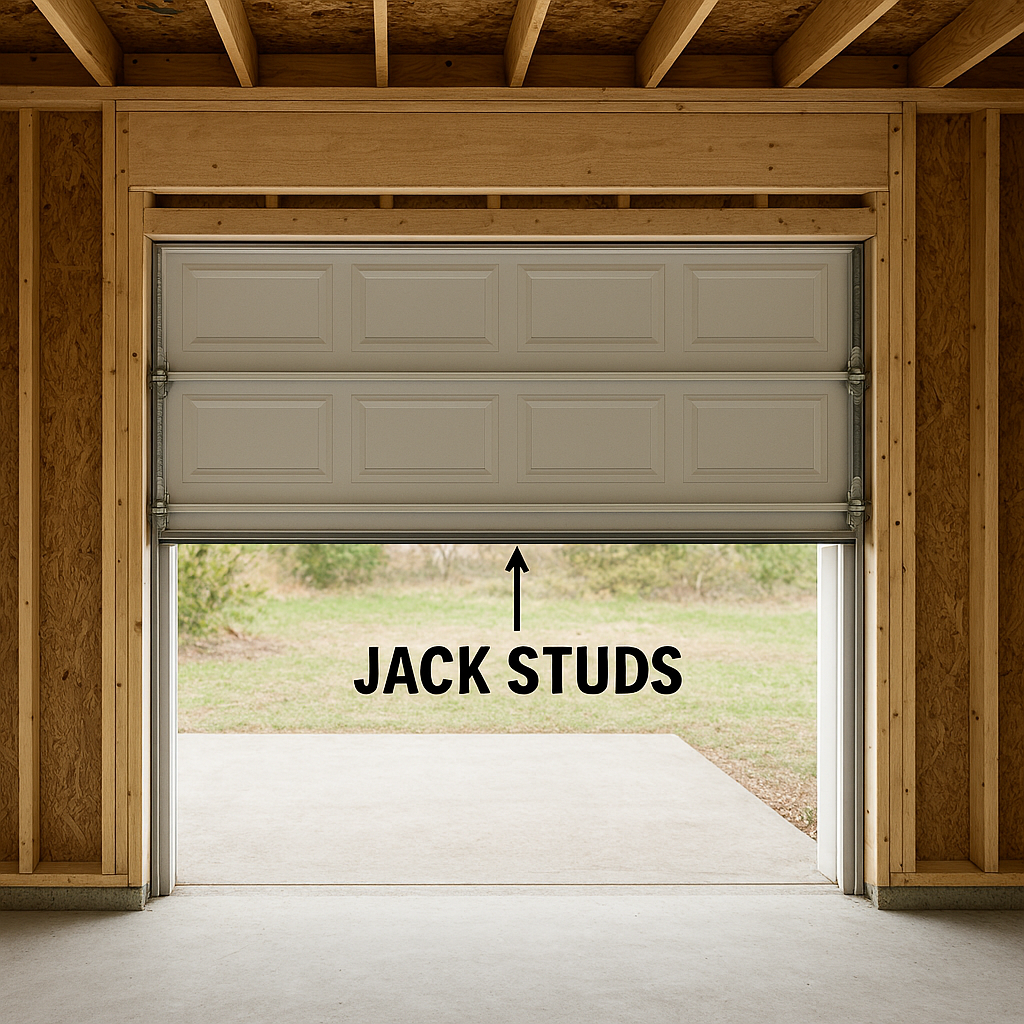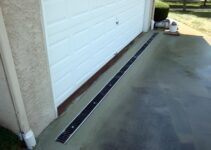Jack Studs in Garage Door Framing
Framing a garage door may seem straightforward, but it requires careful planning and the right structural elements to ensure strength and stability. Among these elements, one of the most critical—yet often overlooked by beginners—is the jack stud.
Also known as a trimmer stud, the jack stud provides essential support to the header and ensures the opening remains strong enough to carry the heavy weight transferred from the roof, upper floors, or any loads above the garage.
Without properly installed jack studs, the framing could weaken over time, leading to sagging headers, misaligned doors, or even serious structural issues
What Is a Jack Stud?

A jack stud is a shortened vertical framing member that works hand in hand with a king stud. The king stud runs the full height of the wall—from the bottom plate at the floor to the top plate at the ceiling. The jack stud, attached directly to the king stud, extends from the bottom plate up to the underside of the header.
The header is a heavy horizontal beam that spans the width of the garage door opening. Its job is to carry the weight of everything above the door opening and transfer that load down into the jack studs. In this way, jack studs act like the legs of a bridge, transferring the heavy weight of the span safely down to the foundation.
In short, the jack stud is the critical link between the header and the ground, making it one of the most important framing members in any garage door opening.
Why Are Jack Studs Important in Garage Door Framing?
Garage doors are typically much wider than standard windows or entry doors, which means they require stronger framing to maintain structural integrity. Jack studs are essential for three main reasons:
-
Carrying the Load
Jack studs directly support the header, which carries the vertical load of the wall above the garage door. Without jack studs, the header would have no solid connection to the foundation. -
Reinforcing the Opening
Garage doors must stay perfectly square to operate correctly. Jack studs add rigidity and prevent the frame from twisting or shifting, ensuring the door opens and closes smoothly. -
Preventing Structural Shifts
Over time, a poorly supported header may sag, causing cracks in drywall, uneven pressure on the garage door tracks, or a misaligned door. Properly installed jack studs prevent this by maintaining stability.
In simple terms, jack studs are not optional—they are a structural necessity.
How Many Jack Studs Do You Need?
The number of jack studs required depends on two main factors:
-
The width of the garage door opening
-
Local building codes and load requirements
For most single-car residential garage doors, one jack stud on each side of the opening is sufficient. However, for wider spans—such as double-car garage doors or oversized custom openings—contractors often use two jack studs per side for additional strength.
Always check local building codes, as requirements can vary depending on snow load, wind load, and other regional factors.
Step-by-Step: Installing Jack Studs in a Garage Door Opening
Framing a garage door with jack studs involves several steps:
-
Layout the Opening
Measure and mark the rough opening for the garage door. Allow for the recommended clearance provided by the manufacturer. -
Install King Studs
Position and secure the king studs on each side of the opening. These full-height studs form the outer edges of the frame. -
Cut and Attach Jack Studs
Measure from the floor to the underside of the header, then cut the jack studs to size. Attach them firmly to the inside of the king studs using nails or screws. -
Set the Header in Place
Cut the header beam to span the opening and rest it directly on top of the jack studs. Secure it tightly to both the jack and king studs. -
Check for Alignment
Use a level to confirm that the studs are plumb and the opening is square. An out-of-square frame will cause problems when installing and operating the garage door. -
Add Cripple Studs (If Required)
If there is space above the header to the top plate, install short cripple studs. These distribute additional loads evenly and tie the wall together.
Common Mistakes to Avoid
Even experienced builders can make errors when framing garage door openings. Some of the most common mistakes include:
-
Using undersized lumber for jack studs or headers, which reduces load capacity.
-
Failing to double up jack studs on wide openings, leaving the header under-supported.
-
Not fastening jack studs tightly to king studs, which can cause separation over time.
-
Ignoring building code requirements, which may result in unsafe framing and failed inspections.
Taking the time to size and install jack studs correctly will save costly repairs later.
Professional Tips
-
Use construction adhesive between the jack and king stud for added strength.
-
Choose engineered lumber or laminated veneer lumber (LVL) for headers in extra-wide openings.
-
Double-check all measurements before cutting—the accuracy of the jack stud height determines how well the header will sit.
-
For DIY projects, always consult a structural engineer or local building authority if unsure.
Conclusion
Although jack studs are smaller than many other framing members, their role in garage door framing is critical. They provide the strength and stability needed to support the header, transfer heavy loads safely, and keep the garage door opening square and secure.
Whether you are tackling a DIY project or working as a professional contractor, understanding the purpose and proper installation of jack studs will ensure your garage door framing remains solid for decades.


